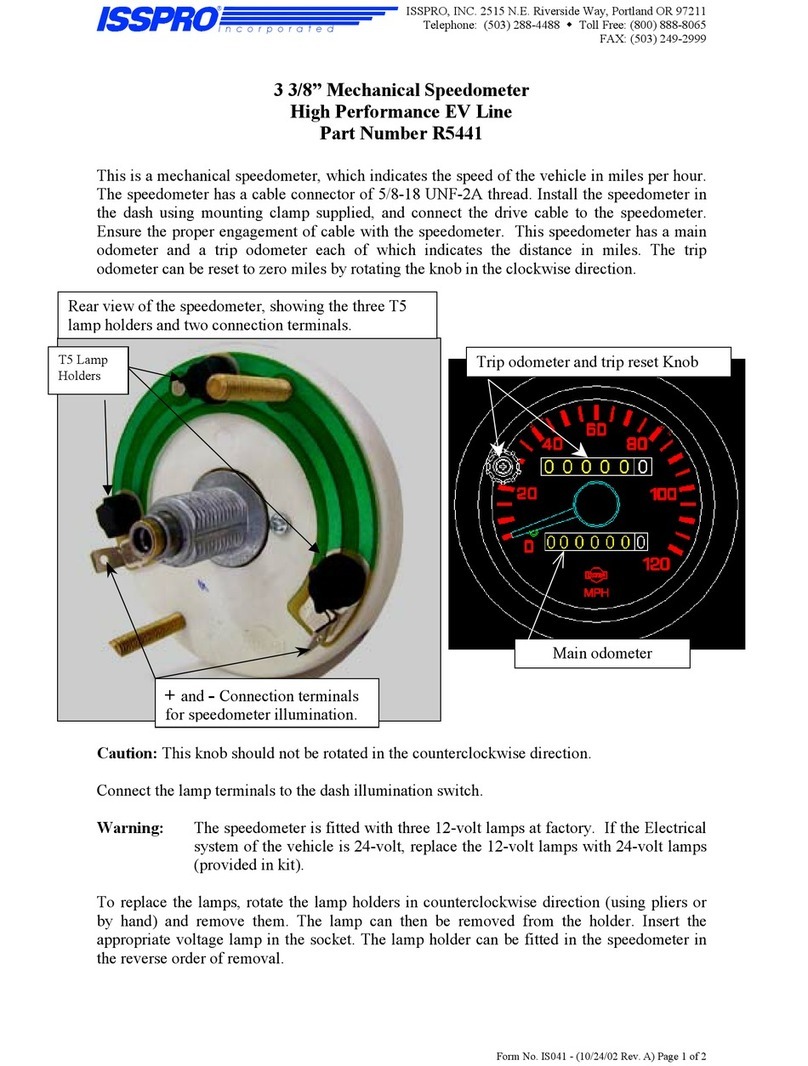EV Electrical Gauge Installation Instruction
Installation (see Diagram on reverse)
1. Disconnect the negative (-) battery cable.
2. Mount gauge to dash in a 2 1/16” hole for 2 1/16” gauges, or 1/32 larger than gauge case diameter.
Insert gauge into hole, connect all wire terminations (including lighting), then secure with supplied
mounting hardware.
3. Check voltage printed on gauge case to ensure it is correct for your application.
270
°
Full Sweep Temperature and Pressure Gauges
1. Determine signal AMP box mounting location, preferably inside firewall (passenger compartment)
for protection from engine compartment environment. Before selecting location, check that the
cable harness length is sufficient to reach both gauge and sender. If mounting with screws (not
included), drill holes to match case mounting holes (11/64”). If module will be mounted with
double-sided adhesive tape (not included), surface must be free of dirt and grease before mounting,
then mount module to pre-selected location. Double sided tape is not recommended for warm
climates.
2. Install sender. (Use a cut-away socket in tight or recessed locations.) Route sender wires through
existing hole in firewall or drill a 3/4” dia. Hole and use a grommet (not included) to protect wires.
Connect wires to sender, once sending unit is installed.
3. Locate a clean chassis ground near the module. Ground module using black 18-gauge wire with lug
terminal (wire not included).
4. Locate a terminal on vehicle’s fuse panel to supply 12v ignition power to the module, using 18
gauge red wire (not included).
5. Connect module harness to gauge.
6. Use wire ties to hold wire assemblies together, along vehicle chassis.
7. Reconnect negative (-) battery cable.
Tech Tips
1. If proper module location cannot be found (protected from engine compartment), use electrical
grade R.T.V. silicone to seal case around terminal block assembly.
2. To insure proper operation, check that the terminal block terminations are free from
contaminants and are securely fastened for good electrical connections.
3. Preferred electrical connection is direct to ignition source protected by a one Amp fuse and
switch.
Note: Gauge to be used only with original module to achieve accurate gauge readings (calibrated
together).
90
°
Electrical Gauges
Gauges have three terminal studs, one marked “+” for system voltage, one marked “S” to be used to
connect to the appropriate sending unit, and one marked “ ” to be connected to a clean chassis
ground. Exception: ammeter has only two studs (see diagram). Do not connect sending unit to
system voltage terminal, damage can occur!
Troubleshooting
90º Electrical gauges that show full scale reading upon installation: Remove sending unit wire at
gauge. Gauge pointer should return to left side of scale. Solution: sending unit or wire is shorted to
ground. Check leads, if good then ground sending unit wire to ground terminal. Gauge pointer
should go to full scale. If it does, sending unit is not functional. If it does not, gauge is not
functional.
270º Electrical gauges that exhibit non-operational indications: To individually check components
(gauges & sending units) for proper operation, remove the sending unit connector and short the two
wires together coming from the driving circuit box. When shorting these wires together, watch the
gauge for pointer movement. A momentary pointer movement from low scale to approximately 45
degrees and then back to the low scale limit (stop pin) will be seen if the gauge and driving circuit
box are functioning properly. If not, then the gauge and or driving circuit box have a problem. If
the gauge and driving circuit box are functional, then the sending unit should be checked next. This
means that the sending unit needs to be measured. You can measure resistance by attaching an
ohmmeter to the two leads in the sending unit’s connector. You should see a measurement of
approximately 1000 Ohms at room temperatures. Sending unit AMP signal box gauges are a
calibrated unit. If any portion of the unit is inoperable, entire “set” must be replaces.
90º Electrical gauges that do not operate (no reading):
Wiring
Use 18 AWG wire and eyelet terminals (not included). Ammeters require at least a 10 AWG wire.
Note: 18 AWG wire may be used to extend module-to-gauge distance for pillar-mount installation
of Full Sweep pressure and temperature gauges.
Lighting
Gauges have one or two twist-base lamp assemblies with two ¼” blade terminations for easy
hookup. Attach a wire from one blade terminal to dash lights, or dash light dimmer switch and
second wire to ground from other blade terminal. Either wire can be connected to either blade
terminal. If replacing a gauge with one wire, the second wire can be grounded to gauge ground
terminal for 90º electrical gauges, or if a metal dash is involved, it can be fastened to a mounting
bracket stud.
Limited Warranty
ISSPRO, Inc. warrants to the consumer that its analog gauge products will be free from defects in
materials or workmanship for 12 months following purchase by the end user. Warranty is limited to
replacement or credit at Isspro’s option, of defective parts within the warranty period. Parts must be
returned, prepaid, to the original purchase point for warranty inspection. This warranty does not
apply to misapplication, misuse, negligence, or accident. This warranty is in lieu of any other
expressed or implied warranties, including any implied warranty of merchantability or fitness for a






















